Serving 2,202 students in grades 9-12, Saginaw High School ranks in the top 50% of all schools in Texas for overall test scores (math proficiency is top 50%, and reading proficiency is top 50%).
The percentage of students achieving proficiency in math is 42% (which is higher than the Texas state average of 41%). The percentage of students achieving proficiency in reading/language arts is 51% (which is equal to the Texas state average of 51%).
The student:teacher ratio of 15:1 is higher than the Texas state level of 14:1.
Minority enrollment is 73% of the student body (majority Hispanic), which is lower than the Texas state average of 75% (majority Hispanic).
Quick Stats (2025)
- Grades: 9-12
- Enrollment: 2,202 students
- Student:Teacher Ratio: 15:1
- Minority Enrollment: 73%
- Graduation Rate: 96% (Top 10% in TX)
- Overall Testing Rank: Top 50%
- Math Proficiency: 42% (Top 50%)
- Reading Proficiency: 51% (Top 50%)
- Science Proficiency: 57% (Top 20%)
- Source: National Center for Education Statistics (NCES), TX Dept. of Education
Top Rankings
Saginaw High School ranks among the top 20% of public schools in Texas for:
Category
Attribute
Science Proficiency
Graduation Rate
Diversity
School Overview
Saginaw High School's student population of 2,202 students has grown by 16% over five school years.
The teacher population of 145 teachers has grown by 16% over five school years.
Grades Offered
Grades 9-12
Total Students
2,202 students

Gender %
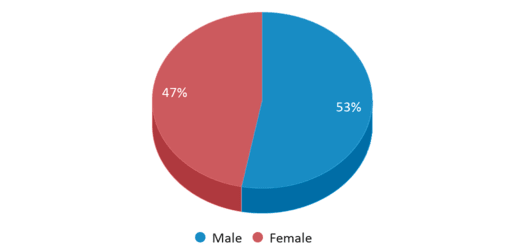
Total Classroom Teachers
145 teachers

Students by Grade
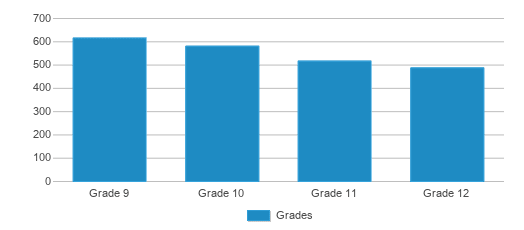
School Rankings
Saginaw High School ranks within the top 50% of all 8,188 schools in Texas (based off of combined math and reading proficiency testing data).
The diversity score of Saginaw High School is 0.73, which is more than the diversity score at state average of 0.64. The school's diversity has stayed relatively flat over five school years.
Overall Testing Rank
#3614 out of 8188 schools
(Top 50%)
(Top 50%)
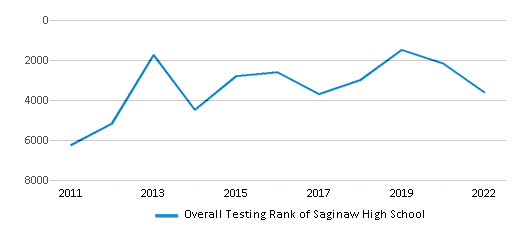
Math Test Scores (% Proficient)
42%
41%
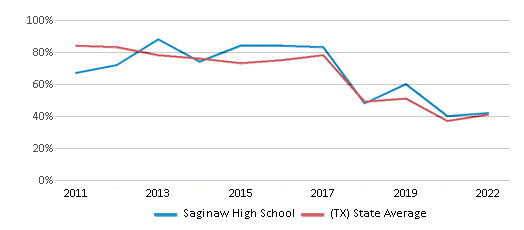
Reading/Language Arts Test Scores (% Proficient)
51%
51%

Science Test Scores (% Proficient)
57%
46%
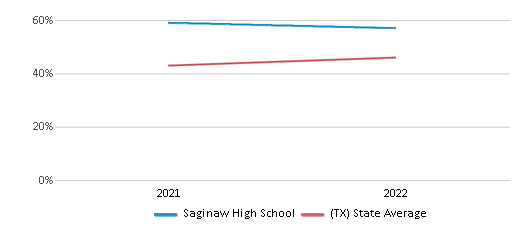
Student : Teacher Ratio
15:1
14:1
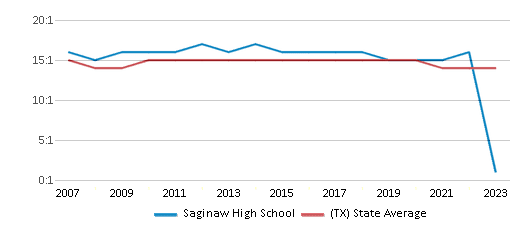
American Indian
n/a
n/a
Asian
9%
6%
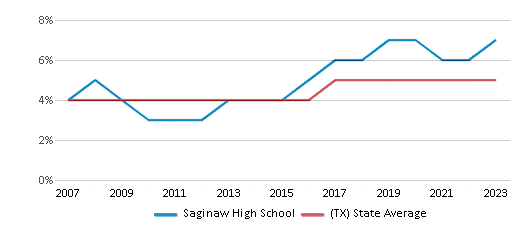
Hispanic
38%
53%
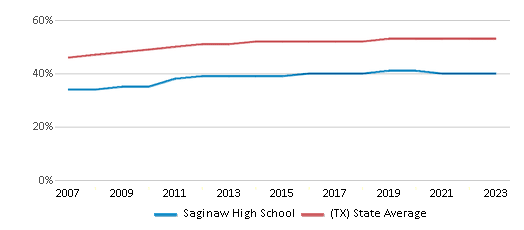
Black
22%
13%
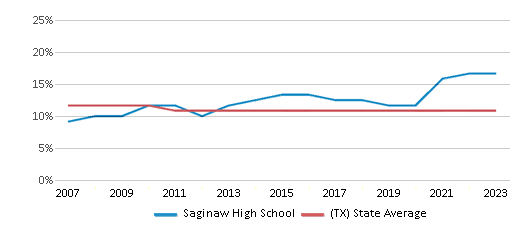
White
27%
25%
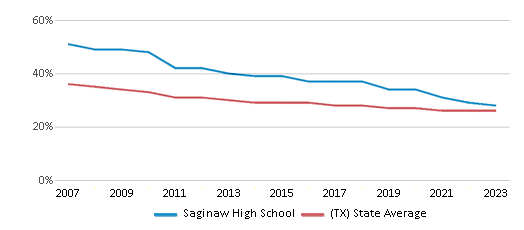
Hawaiian
n/a
n/a
Two or more races
4%
3%
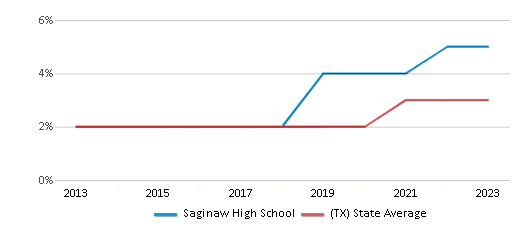
All Ethnic Groups

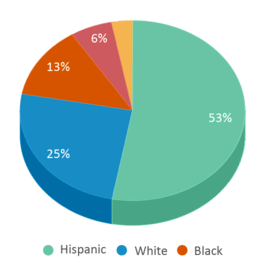
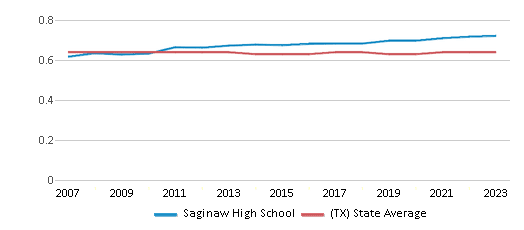
Graduation Rate
96%
90%
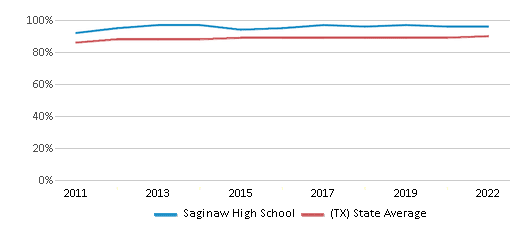
Participates in the National School Lunch Program (NSLP)
Yes
Eligible for Free Lunch
42%
57%

Eligible for Reduced Lunch
9%
5%

School Statewide Testing
School District Name
Source: National Center for Education Statistics (NCES), TX Dept. of Education
Profile last updated: 02/09/2025
Frequently Asked Questions
What is Saginaw High School's ranking?
Saginaw High School is ranked #3614 out of 8,188 schools, which ranks it among the top 50% of public schools in Texas.
What schools are Saginaw High School often compared to?
Saginaw High Schoolis often viewed alongside schools like Boswell High School by visitors of our site.
What percent of students have achieved state testing proficiency in math and reading?
42% of students have achieved math proficiency (compared to the 41% TX state average), while 51% of students have achieved reading proficiency (compared to the 51% TX state average).
What is the graduation rate of Saginaw High School?
The graduation rate of Saginaw High School is 96%, which is higher than the Texas state average of 90%.
How many students attend Saginaw High School?
2,202 students attend Saginaw High School.
What is the racial composition of the student body?
38% of Saginaw High School students are Hispanic, 27% of students are White, 22% of students are Black, 9% of students are Asian, and 4% of students are Two or more races.
What is the student:teacher ratio of Saginaw High School?
Saginaw High School has a student ration of 15:1, which is higher than the Texas state average of 14:1.
What grades does Saginaw High School offer ?
Saginaw High School offers enrollment in grades 9-12
What school district is Saginaw High School part of?
Saginaw High School is part of Eagle MT-Saginaw Independent School District.
School Reviews
4 5/13/2017
The good: Teachers care about the performance of the students, the athletic programs are mostly competitive, the students get along with each other and engage in cooperative learning. The debate program excels. The bad: The counselors do not show much interest in helping the students make decisions in terms of academics. The theater program could be so much more than it is. There is some drug use among the students at school. The debate program, and by and large most non-athletic programs go unnoticed by the administration. The students of this school outperform students of similar backgrounds who attend other public schools.
2 1/10/2011
If you like crowded halls, lack of respect from students, and you want to instill fear or hatred for school, then this is the school for your kids.
Review Saginaw High School. Reviews should be a few sentences in length. Please include any comments on:
- Quality of academic programs, teachers, and facilities
- Availability of music, art, sports and other extracurricular activities
Recent Articles

What Is A Charter School?
Explore the world of charter schools in this comprehensive guide. Learn about their history, how they operate, and the pros and cons of this educational innovation. Discover key facts about charter schools, including admission policies, demographics, and funding, as well as what to look for when considering a charter school for your child.

10 Reasons Why High School Sports Benefit Students
Discover the 10 compelling reasons why high school sports are beneficial for students. This comprehensive article explores how athletics enhance academic performance, foster personal growth, and develop crucial life skills. From improved fitness and time management to leadership development and community representation, learn why participating in high school sports can be a game-changer for students' overall success and well-being.

February 05, 2025
Understanding the U.S. Department of Education: Structure, Impact, and EvolutionWe explore how the Department of Education shapes American education, from its cabinet-level leadership to its impact on millions of students, written for general audiences seeking clarity on this vital institution.





